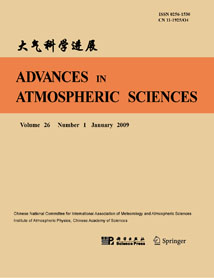| [1] |
Xia Daqing, Zheng Liangjie,
1986: NUMERICAL SIMULATION OF THE GENERATION OF MESOSCALE CONVECTTVE SYSTEMS IN LARGE-SCALE ENVIRONMENT, ADVANCES IN ATMOSPHERIC SCIENCES, 3, 360-370.
doi: 10.1007/BF02678656
|
| [2] |
ZHOU Lingli, DU Huiliang, ZHAI Guoqing, WANG Donghai,
2013: Numerical Simulation of the Sudden Rainstorm Associated with the Remnants of Typhoon Meranti (2010), ADVANCES IN ATMOSPHERIC SCIENCES, 30, 1353-1372.
doi: 10.1007/s00376-012-2127-3
|
| [3] |
Chen Changsheng, Qin Zenghao,
1985: NUMERICAL SIMULATION OF TYPHOON SURGES ALONG THE EAST COAST OF ZHEJIANG AND JIANGSU PROVINCES, ADVANCES IN ATMOSPHERIC SCIENCES, 2, 8-19.
doi: 10.1007/BF03179732
|
| [4] |
ZENG Zhihua, DUAN Yihong, LIANG Xudong, MA Leiming, Johnny Chung-leung CHAN,
2005: The Effect of Three-Dimensional Variational Data Assimilation of QuikSCAT Data on the Numerical Simulation of Typhoon Track and Intensity, ADVANCES IN ATMOSPHERIC SCIENCES, 22, 534-544.
doi: 10.1007/BF02918486
|
| [5] |
Fuzhong WENG, Xinwen YU, Yihong DUAN, Jun YANG, Jianjie WANG,
2020: Advanced Radiative Transfer Modeling System (ARMS): A New-Generation Satellite Observation Operator Developed for Numerical Weather Prediction and Remote Sensing Applications, ADVANCES IN ATMOSPHERIC SCIENCES, 37, 131-136.
doi: 10.1007/s00376-019-9170-2
|
| [6] |
GU Jianfeng, Qingnong XIAO, Ying-Hwa KUO, Dale M. BARKER, XUE Jishan, MA Xiaoxing,
2005: Assimilation and Simulation of Typhoon Rusa (2002) Using the WRF System, ADVANCES IN ATMOSPHERIC SCIENCES, 22, 415-427.
doi: 10.1007/BF02918755
|
| [7] |
ZHANG Xiaoyan, WANG Bin, JI Zhongzhen, Qingnong XIAO, ZHANG Xin,
2003: Initialization and Simulation of a Typhoon Using 4-Dimensional Variational Data Assimilation-Research on Typhoon Herb(1996), ADVANCES IN ATMOSPHERIC SCIENCES, 20, 612-622.
doi: 10.1007/BF02915504
|
| [8] |
Lin DENG, Wenhua GAO, Yihong DUAN, Yuqing WANG,
2019: Microphysical Properties of Rainwater in Typhoon Usagi (2013): A Numerical Modeling Study, ADVANCES IN ATMOSPHERIC SCIENCES, 36, 510-526.
doi: 10.1007/s00376-019-8170-6
|
| [9] |
YI Bingqi,
2010: Near-equatorial Typhoon Development: Climatology and Numerical Simulations, ADVANCES IN ATMOSPHERIC SCIENCES, 27, 1014-1024.
doi: 10.1007/s00376-009-9033-3
|
| [10] |
ZHOU Lingli, ZHAI Guoqing, HE Bin,
2011: Numerical Study of the Mesoscale Systems in the Spiral Rainband of 0509 Typhoon Matsa, ADVANCES IN ATMOSPHERIC SCIENCES, 28, 118-128.
doi: 10.1007/s00376-010-0023-2
|
| [11] |
Chen Panqin,
1985: NUMERICAL SIMULATION FOR THE EFFECTS OF PBL AND THE SURFACE ON POLLUTANT CONCENTRATIONS, ADVANCES IN ATMOSPHERIC SCIENCES, 2, 251-259.
doi: 10.1007/BF03179757
|
| [12] |
LIU Huizhi, Sang Jianguo,
2011: Numerical Simulation of Roll Vortices in the Convective Boundary Layer, ADVANCES IN ATMOSPHERIC SCIENCES, 28, 477-482.
doi: 10.1007/s00376-010-9229-6
|
| [13] |
Zeng Qingcun, Yuan Chongguang, Lu Peisheng, Li Rongfeng,
1984: ON THE GENERATION AND MAINTENANCE OF ATMOSPHERIC DISTURBANCES, ADVANCES IN ATMOSPHERIC SCIENCES, 1, 1-18.
doi: 10.1007/BF03187611
|
| [14] |
LI Qingqing, DUAN Yihong, YU Hui, FU Gang,
2010: Finescale Spiral Rainbands Modeled in a High-Resolution Simulation of Typhoon Rananim (2004), ADVANCES IN ATMOSPHERIC SCIENCES, 27, 685-704.
doi: 10.1007/s00376-009-9127-y
|
| [15] |
Meiying DONG, Chunxiao JI, Feng CHEN, Yuqing WANG,
2019: Numerical Study of Boundary Layer Structure and Rainfall after Landfall of Typhoon Fitow (2013): Sensitivity to Planetary Boundary Layer Parameterization, ADVANCES IN ATMOSPHERIC SCIENCES, 36, 431-450.
doi: 10.1007/s00376-018-7281-9
|
| [16] |
Jia LIANG, Liguang WU, Guojun GU,
2018: Numerical Study of the Influences of a Monsoon Gyre on Intensity Changes of Typhoon Chan-Hom (2015), ADVANCES IN ATMOSPHERIC SCIENCES, 35, 567-579.
doi: 10.1007/s00376-017-7155-6
|
| [17] |
Xinguan DU, Haishan CHEN, Qingqing LI, Xuyang GE,
2023: Urban Impact on Landfalling Tropical Cyclone Precipitation: A Numerical Study of Typhoon Rumbia (2018), ADVANCES IN ATMOSPHERIC SCIENCES, 40, 988-1004.
doi: 10.1007/s00376-022-2100-8
|
| [18] |
LI Yunying, ZHAO Jiaozhi,
2007: Roles of Mesoscale Terrain and Latent Heat Release in Typhoon Precipitation: A Numerical Case Study, ADVANCES IN ATMOSPHERIC SCIENCES, 24, 35-43.
doi: 10.1007/s00376-007-0035-8
|
| [19] |
ZHAO Ying, WANG Bin,
2008: Numerical Experiments for Typhoon Dan Incorporating AMSU-A Retrieved Data with 3DVM, ADVANCES IN ATMOSPHERIC SCIENCES, 25, 692-703.
doi: 10.1007/s00376-008-0692-2
|
| [20] |
Sun Tingkai, Tan Zhemin,
2001: Numerical Simulation Study for the Structure and Evolution of Tropical Squall Line, ADVANCES IN ATMOSPHERIC SCIENCES, 18, 117-138.
doi: 10.1007/s00376-001-0008-2
|















 AAS Website
AAS Website 
 AAS WeChat
AAS WeChat 
 DownLoad:
DownLoad: